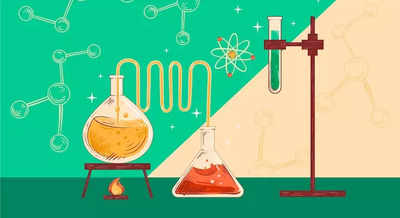- News
- Education News
- Learning with TOI News
- What is inorganic chemistry? Simple explanation
Trending
This story is from June 11, 2023
What is inorganic chemistry? Simple explanation
Inorganic chemistry deals with the study of non-living matter, including minerals, metals, nonmetals, and their compounds, which do not involve carbon-hydrogen bonds. Inorganic compounds can exhibit different physical states, colors, conductivity, solubility, and reactivity, and find useful applications in various fields such as materials science, medicine, environmental science, energy production, and electronics.

Representative image (Source: Freepik)
Inorganic chemistry is the branch of chemistry that focuses on the study of non-living matter, specifically compounds that do not contain carbon-hydrogen (C-H) bonds. It investigates the properties, structure, composition, and reactions of inorganic compounds, which include minerals, metals, nonmetals, and their respective compounds. Let's explore inorganic chemistry in simple terms.
Inorganic chemistry primarily deals with compounds that do not involve carbon atoms bonded to hydrogen atoms (C-H bonds).These compounds are known as inorganic compounds. In contrast, organic chemistry focuses on the study of compounds that contain carbon and hydrogen bonds. For
example, Sodium chloride (NaCl), commonly known as table salt, is an inorganic compound. It consists of sodium (Na) and chlorine (Cl) atoms but does not contain carbon-hydrogen bonds.
Inorganic compounds encompass a wide range of substances, including minerals, metals, nonmetals, salts, acids, bases, and transition metal complexes. For example: Iron oxide (Fe2O3), also known as rust, is an inorganic compound formed by the reaction of iron (Fe) with oxygen (O2).
Inorganic compounds exhibit diverse properties and undergo various reactions. These compounds can have different physical states (solid, liquid, or gas) and can possess distinct colors, conductivity, solubility, and reactivity. For example: Hydrochloric acid (HCl) is an inorganic compound that is a strong acid. It is highly corrosive and reacts with certain metals, producing hydrogen gas and metal chloride.
Inorganic chemistry finds numerous practical applications in various fields, including materials science, medicine, environmental science, energy production, and electronics. For example, Silicon (Si), an inorganic element, is widely used in the semiconductor industry to produce computer chips and electronic devices.
In summary, inorganic chemistry is the study of non-living matter and compounds that do not contain carbon-hydrogen bonds. It explores the properties, reactions, and applications of inorganic compounds, which include minerals, metals, nonmetals, and their respective compounds. By understanding inorganic chemistry, scientists can develop new materials, explore industrial processes, and gain insights into the behavior of non-living matter.
(The content is generated with the assistance of Artificial Intelligence)
Carbon and Inorganic Chemistry
Inorganic chemistry primarily deals with compounds that do not involve carbon atoms bonded to hydrogen atoms (C-H bonds).These compounds are known as inorganic compounds. In contrast, organic chemistry focuses on the study of compounds that contain carbon and hydrogen bonds. For
example, Sodium chloride (NaCl), commonly known as table salt, is an inorganic compound. It consists of sodium (Na) and chlorine (Cl) atoms but does not contain carbon-hydrogen bonds.
Types of Inorganic Compounds
Inorganic compounds encompass a wide range of substances, including minerals, metals, nonmetals, salts, acids, bases, and transition metal complexes. For example: Iron oxide (Fe2O3), also known as rust, is an inorganic compound formed by the reaction of iron (Fe) with oxygen (O2).
Properties and Reactions
Inorganic compounds exhibit diverse properties and undergo various reactions. These compounds can have different physical states (solid, liquid, or gas) and can possess distinct colors, conductivity, solubility, and reactivity. For example: Hydrochloric acid (HCl) is an inorganic compound that is a strong acid. It is highly corrosive and reacts with certain metals, producing hydrogen gas and metal chloride.
Applications
Inorganic chemistry finds numerous practical applications in various fields, including materials science, medicine, environmental science, energy production, and electronics. For example, Silicon (Si), an inorganic element, is widely used in the semiconductor industry to produce computer chips and electronic devices.
In summary, inorganic chemistry is the study of non-living matter and compounds that do not contain carbon-hydrogen bonds. It explores the properties, reactions, and applications of inorganic compounds, which include minerals, metals, nonmetals, and their respective compounds. By understanding inorganic chemistry, scientists can develop new materials, explore industrial processes, and gain insights into the behavior of non-living matter.
(The content is generated with the assistance of Artificial Intelligence)
End of Article
FOLLOW US ON SOCIAL MEDIA










